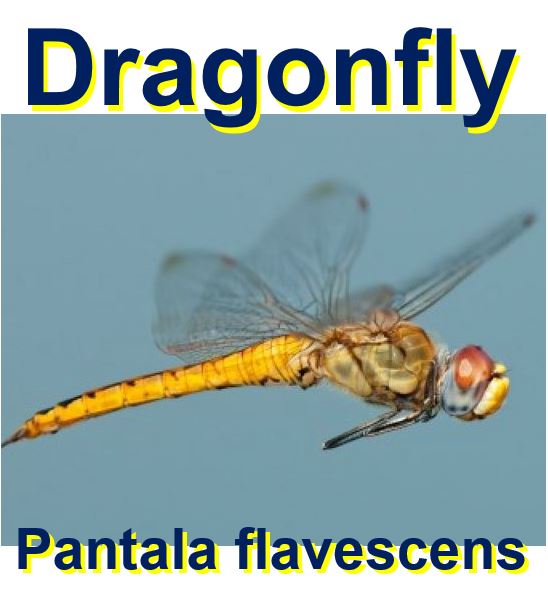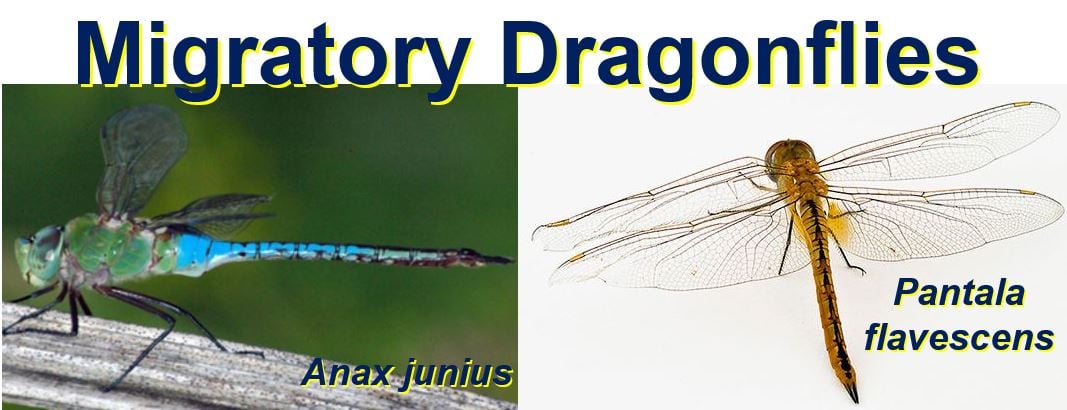The tiny dragonfly (Pantala flavescens), which is barely 1.5 inches long (3.8cm), is the longest flier in the world regarding distance, says a group of scientists. It is known to fly non-stop across the Indian Ocean from Asia to Africa.
This prolific long-distance traveler – known as the Globe Skimmer or Wandering Glider – flies thousands of miles over seas and oceans, crossing continents and breeding across the world, researchers from Rutgers University-Newark in the United States wrote in the scientific journal PLOS ONE (citation below).
Senior author, Jessica Ware, an assistant professor of biology at the University’s College of Arts and Sciences, and colleagues say their evidence is in the insects’ genes.
 If they exist all over the world and all the genes are the same, it must mean that this amazing dragonfly is flying globally and intermingling. (Image: rutgers.egu)
If they exist all over the world and all the genes are the same, it must mean that this amazing dragonfly is flying globally and intermingling. (Image: rutgers.egu)
The biologists said that Pantala flavescens has been found in locations as far apart as South America, India, Korea, Japan, eastern Canada and Texas. In all these places its genetic profiles have been similar – there is only one explanation for this.
Dragonfly has a common worldwide gene pool
These amazing creatures appear to be travelling remarkably-long distances for their tiny size, breeding with each other, and creating a common global gene pool that would not be possible if they did not intermingle.
Prof. Ware said regarding these insects’ genes:
“This is the first time anyone has looked at genes to see how far these insects have traveled. If North American Pantala only bred with North American Pantala, and Japanese Pantala only bred with Japanese Pantala, we would expect to see that in genetic results that differed from each other.”
“Because we don’t see that, it suggests the mixing of genes across vast geographic expanses.”
 Pantala flavescens leaves India when the dry season starts and flies across the Indian Ocean to East Africa, seeking moisture. (Image: adapted from plos.org)
Pantala flavescens leaves India when the dry season starts and flies across the Indian Ocean to East Africa, seeking moisture. (Image: adapted from plos.org)
How do they manage to meet up?
So, how do these tiny creatures from different continents manage to meet and breed with each other? They are not huge birds with giant wingspans or massive whales that we would expect to travel remarkable distances.
The biologists believe their amazing achievement is down to the way their bodies have evolved.
Prof. Ware said:
“These dragonflies have adaptations such as increased surface areas on their wings that enable them to use the wind to carry them. They stroke, stroke, stroke and then glide for long periods, expending minimal amounts of energy as they do so.”
Dragonflies have actually been observed crossing vast seas and oceans non-stop. There have been reported observations of single flights from Asia to Africa, across the Indian Ocean.
Dragonflies follow the weather
Co-author, postgraduate biology student during the study, Daniel Troast, who analysed the DNA samples in Prof. Ware’s lab, said:
“They are following the weather. They’re going from India where it’s dry season to Africa where it’s moist season, and apparently they do it once a year.”
 Prof. Jessica Ware and Daniel Troast. (Images: Rutgers)
Prof. Jessica Ware and Daniel Troast. (Images: Rutgers)
The dragonfly follows places where moisture levels are high – it needs moisture to reproduce. The quest for moisture is what drives these insects to attempt such amazingly long distances, which Prof. Ware describes as a ‘kind of suicide mission’.
The species depends on moisture. The gigantic trips are worth it, even if many die along the way, as long as enough make it and reproduce, thus ensuring the species’ survival.
Some fly non-stop others stop along the way
Pantalas’ flight patterns appear to vary, the scientists found. The toughest and fittest dragonflies might fly the whole journey in one go, catching strong air currents or even hurricane winds and gliding all the way.
 Most dragonflies stay within 36 feet of where they were born, except for Anax junius and Pantala flavescens.
Most dragonflies stay within 36 feet of where they were born, except for Anax junius and Pantala flavescens.
The less hardy ones are more like puddle jumpers – literally. The insect needs fresh water to mate and lay its eggs. During a flight while riding a weather current, if they see a fresh water pool created by a rainstorm – even on a tiny island in the middle of a huge ocean – they are likely to stop at these pools to mate, the authors wrote.
As soon as the eggs have hatched and the babies are mature enough to fly, which only takes a few weeks, the juvenile dragonflies join the swarm’s intercontinental and now multi-generational journey right where their parents left off.
More comprehensive studies required
The researchers say that for the moment, the details of these insects’ flight patterns and travelling behaviours are an educated best guess.
There are still many loose ends and unanswered questions which need to be resolved, said Prof. Ware. So far, their study has established that there is a global population of intermingling dragonflies.
Troast and Ware now hope that researchers can work on getting more comprehensive data on the dragonflies’ routes.
Tracking these little creatures is no easy task. You cannot attach tracking devices to these tiny animals – they are too small.
Beats Monarch butterfly handsomely
Prof. Ware and colleagues say this dragonfly makes its main long-distance flying rival, the Monarch Butterfly, seem like a couch potato in comparison.
Troast said:
“Monarch butterflies migrating back and forth across North America were thought to be the longest migrating insects [traveling about 2,500 miles or 4,023 km each way], but Pantala completely destroys any migrating record they would have.”
Experts estimate that Pantala’s flight range is at least 4,400 miles (7,081 km). Even Charles Lindbergh (1902-1974), who flew solo from New York to Paris in 1927, is beaten by this dragonfly by several hundred miles.
Pantala and its cousin Green Darner (Anax junius) are unique in the world of dragonflies regarding long-distance flying. Most dragonflies hover about around ponds and rarely venture more than thirty-six feet from where they were born.
Citation: “A Global Population Genetic Study of Pantala flavescens,” Daniel Troast, Frank Suhling, Hiroshi Jinguji, Göran Sahlén & Jessica Ware. PLOS ONE. 2 March, 2016. DOI: DOI: 10.1371/journal.pone.0148949.
Video – Dragonfly birth
This video shows the birth of a Pantala flavescens dragonfly. Within minutes it is ready to fly.
